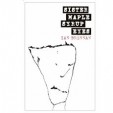“There is more than one victim for every rape,” Ian Brennan writes in the Preface to his novella Sister Maple Syrup Eyes, which explores, in language as searing as it is poetic, the effects of sexual assault not only on the immediate victim but also on her partner.
The book is rooted in Brennan’s personal experience. When he was twenty-one, his first love was beaten and raped by a family friend, an incident that “destabilized the entire trajectory of my young life, reshaping everything since and, retroactively, all which came before.”
Sister Maple Syrup Eyes follows much the same painful trajectory from the point of view of a young man, Kristian. The novella begins when Kristian’s girlfriend, Dawn, reaches him by phone while he is on a business trip and tells him that she’s been raped. Recalling that moment, Kristian thinks, “[I]t took minutes to react, the first in a long chain of small reactions that would unfold slowly over time. It would be many years before I could fully comprehend what she’d said.”
The novella then goes back to Kristian and Dawn’s first meeting, under circumstances that are also disturbing. While Kristian is on nursing duty at a local hospital, Dawn arrives for treatment of physical abuse by her then-boyfriend, who’d been angered by her attempts to leave him. Realizing that she can’t return to the apartment she shared with her boyfriend, and that she has nowhere else to go, Kristian ends up taking her back to his own place in what he expects will be a temporary arrangement. Instead, the two of them become lovers.
Through evocatively detailed writing, Brennan makes Kristian’s affection for Dawn apparent. In one passage, after he visits Dawn at a school where she is working as a teaching assistant for deaf students, Kristian tries to re-create the students’ soundless world by hanging blankets over the windows of his and Dawn’s apartment and by plugging his ears with cotton. “I stayed that way for over an hour,” Kristian observes. “I tried to imagine a world without sound. I tried imagining a world without her. I could do neither.”
Later, while taking a sculpture class at a local community college, he reflects on his repeated attempts—failed ones, in his view—to capture Dawn’s beauty:
(Eventually, Dawn and Kristian have a daughter, Jo, and the story surrounding her is devastating in and of itself. Jo is diagnosed with a variety of leukemia that proves terminal, and the stress of the diagnosis and illness leads Dawn to a heroin addiction that she overcomes after great difficulty.)
After Dawn’s rape, it is revealed that the perpetrator, named “_____” by Kristian (“I have taken [his name] from him”), was a childhood friend of Kristian. Chillingly, Dawn had met him once before, at his own wedding, where she and Kristian were among the few guests who had accepted the invitation.
When, eventually, _____ is given the maximum sentence for the rape, it comes only after a painful process that is all too familiar to rape victims: Dawn is cross-examined for seven hours, blamed, and revictimized. And while _____ is eligible for parole in six years, Dawn is never freed from the consequences of the rape. As Brennan writes, “For the victim, rape is always a life sentence.”
Not wanting to give too many of the details away, I’ll just say that there’s no fairy-tale ending to Kristian and Dawn’s relationship, largely owing to the emotional fallout from the rape. The passage of time seems to do little to lessen the intensity of Kristian’s grieving over the toll the assault has taken, and over the end of his relationship with Dawn. His ongoing reflection on both feels not so much like a balm for his wounds as a compulsion to retrace them, leaving them more raw than mended. This portrayal of the consequences of trauma seems far more authentic than the comforting but mythical notion that time heals all wounds.
At one point, Kristian observes, “I’m now more than twice the age I was when I last saw you [Dawn]. But you resonate inside me still. Some echo of what was, that never quite decays.”
Even so, Kristian seems to come to a greater understanding of his situation, even if he can’t find peace. Toward the end of the book, when he researches rape at the library, “hoping to locate the error of my ways” regarding Dawn, he learns, “My shortcoming hadn’t been through action, but rather through the thing I hadn’t done, that I could not do, that no one could. To travel back in time and erase the moment that altered all that followed.”
Because of its graphic and emotionally wrenching content, Sister Maple Syrup
Eyes is difficult to read, but it should be difficult to read. In vividly re-creating Kristian’s personal journey, Brennan offers a layered and moving exploration of the truth that “no one whose life is touched by this type of tragedy goes unharmed—usually in deep, delayed, and ineffable ways.”
Would My Pick be Your Pick?
If you're interested in ________, the answer may be "Yes":▪ Yes Means Yes! Visions of Female Sexual Power & a World Without Rape, by Jaclyn Friedman and Jessica Valenti
▪ Transforming a Rape Culture, edited by Emilie Buchwald, Pamela Fletcher, and Marth Roth
▪ Push, by Sapphire
▪ Lucky, by Alice Sebold
▪ Thoughtful explorations of the effects of sexual trauma


